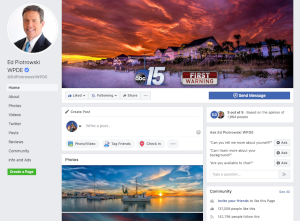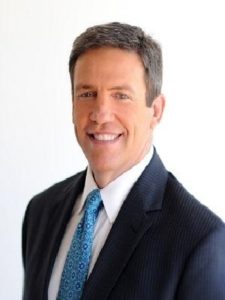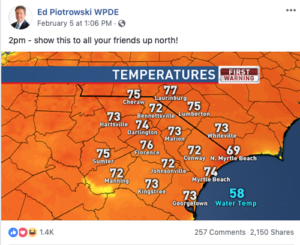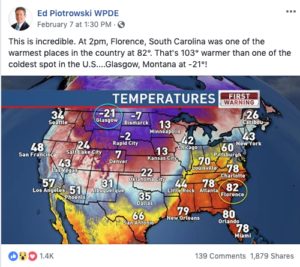Mixing personality with meteorology on Facebook

Any broadcast meteorologist who posts regularly on Facebook knows a picture of your dog will generate more engagement than a picture of the forecast. That really shouldn’t be a surprise. Social media wasn’t designed to be a news platform. It’s a “social” platform. It’s about society and community. It’s about belonging and sharing.
Facebook claims to have 1.52 billion daily active users. That’s a lot of people sharing content. That’s also a lot of people creating content.
So how do broadcast meteorologists make their posts appear in the newsfeed of followers? You can drive yourself crazy trying to figure out Facebook’s algorithms. Or you could spend the time posting.
A Facebook Success Story

Ed Piotrowski is the Chief Meteorologist at WPDE TV 15 in Myrtle Beach, South Carolina (Market #95.) He has spent his entire 28 year broadcast career in the coastal Carolinas, according to his station bio. Ed is a local legend, a regular fixture in the community and trusted forecaster on TV. And he has 142,795 Facebook followers.
You’d think Ed wouldn’t have to work very hard to have an active following on social media. And you’d be wrong.
During one week in early February 2019, Ed posted 68 times on Facebook.
Here’s how those posts break down:
32 weather photos submitted by viewers
14 images of weather maps or data
14 photos or videos of Ed
5 light-hearted weather features (not weather maps)
3 other
0 pictures of Ed’s dog
Ed has developed a reputation as the place to send weather photos for WPDE. That has been a long-term effort and is now an established habit for both casual and professional photographers.
I am more interested in the number of photos/videos of Ed (personality) vs. the number of the weather maps and data (meteorology.) It was an even number of posts: 14 each. Ed tells me that is “purely coincidental.”
 Here’s where it gets interesting. Ed’s personality posts generated 73% more likes and 24% more comments than the meteorology posts. However, the meteorology posts generated 305% more shares!
Here’s where it gets interesting. Ed’s personality posts generated 73% more likes and 24% more comments than the meteorology posts. However, the meteorology posts generated 305% more shares!
There were two meteorology posts that generated about 2000 shares each. If you take them out of the calculation, the meteorology posts had 32% fewer shares than the personality posts.
These two meteorology posts did well because they had universal appeal that was of interest outside the local viewing area, thereby encouraging followers to share with distant friends and family, especially those deep in the heart of the Polar Vortex.
 Although the image featured in the post was a weather map, Ed’s comment was all personality. That also helped drive engagement. These weren’t long drawn out forecast discussions. The text on the two weather map posts had less than two sentences.
Although the image featured in the post was a weather map, Ed’s comment was all personality. That also helped drive engagement. These weren’t long drawn out forecast discussions. The text on the two weather map posts had less than two sentences.
By comparison, most other meteorology posts that simply featured the forecast all got less than 100 shares.
What Can We Learn From This
Clicking the share button on the weather graphics computer and posting a quick pic of a weather map to Facebook is a waste of time.
Ed got over 142,000 people to follow him by posting a mix of content. But personality more than meteorology encourages likes, comments and shares. Meteorology posts work only if you can add sizzle with a quick personal comment.
“Most of the time the weather is quiet so I try to keep people engaged by posting local photos, funny and interesting stuff from here and around the world,” Ed told me. “When the weather gets serious, the number of posts increases dramatically.” More than 68 posts in seven days? Wow.
READ MORE: THE MOST IMPORTANT PART OF THE NEWSCAST
One more thing about the personality posts. They really weren’t pictures of Ed. They were pictures of Ed with other people. “I post everything I do in the community. And I always try to make my posts about the event, not me.”
Another lesson: if you really want to increase engagement online you also need to increase engagement in the community.
Tim Heller is an AMS Certified Broadcast Meteorologist and Talent Coach. He helps local TV stations connect with their community through essential weather information.
Read more News & Insights from HellerWeather
